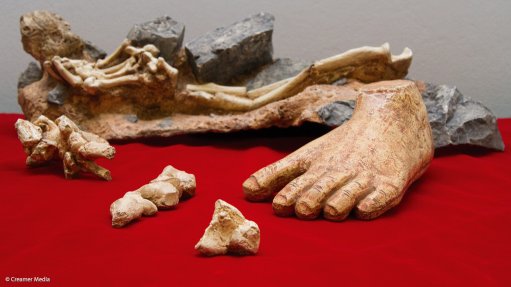
Little foot skeleton of Australopithecus prometheus
Photo by: Duane Daws
An international team of scientists announced on Thursday the determination of new dates for the famous Little Foot skeleton excavated from the globally-famous Sterkfontein Caves in South Africa’s Gauteng province. The team comprises researchers from South Africa, Canada, France and the US. It also announced new dates for tools from the Oldowan culture, also found at Sterkfontein.
Using recently developed technology, the team was able to determine that Little Foot, an individual of the hominid species Australopithecus prometheus, dates from 3.67-million years ago, plus/minus 160 000 years. The unrelated Oldowan tools have now been dated to 2.18-million years, plus/minus 210 000 years.
Previously, proposed dates for Little Foot had ranged from 2.2-million years to nearly 4-million years. These estimates had been derived using different dating techniques. The Oldowan tools had originally been dated to about 1.7-million years ago to 2-million years ago, based on apparently associated animal fossils.
The South African members of the team are Professors Ron Clarke (recently retired as Director of Excavations at Sterkfontein and now Honorary Reader in Palaeoanthropology at the University of the Witwatersrand [Wits]) and Kathleen Kuman (Wits School of Geography, Archaeology and Environmental Studies). Clarke was the original discoverer of Little Foot, while Kuman is a specialist in the Stone Age. The overseas members are Prof Ryan Gibbon of the University of New Brunswick, Canada (who obtained his PhD at Wits); Dr Laurent Bruxelles of the Institut National de Recherches Archéologiques Préventives at the University of Toulouse–Jean Jaurés, France; and Professor Darryl Granger of Purdue University in Indiana in the US.
It was the Purdue Rare Isotope Measurement Laboratory (PRIME Lab) that made the new datings. This is a US national facility for accelerator mass spectrometry (AMS). Granger is a member of PRIME Lab and the project also benefited from the expertise of the lab’s director, physics Professor Marc Caffee.
The new dates were obtained using the recently developed gas-filled magnet detector, which has been added to the AMS system. The AMS was used to detect cosmogenic nuclides in the rock in which the fossils were embedded. These nuclides are created by cosmic rays, which constantly bombard the Earth. In particular, the isotopes Aluminium-26 and Beryllium-10 are sought, for these are created in measurable amounts within quartz by the interaction between the cosmic rays and the silica and oxygen in the rock. The gas-filled magnet detector allows much more accurate measurement of the two targeted isotopes and thus much more accurate dating of fossils.